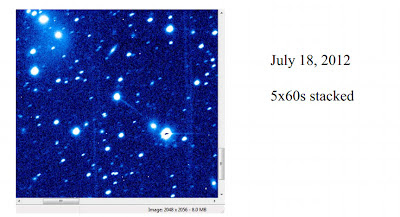M.P.E.C.
2012-N11, issued on 2012 July 9, reports the recovery of the PHA asteroid
1999 XL136 by
R. H. McNaught with the 0.5-m Uppsala Schmidt + CCD in the course of the
E12 Siding Spring Survey.
1999 XL136 was discovered on December 12, 1999 by
LINEAR survey and observed for roughly 1 month (last observation was of January 09, 2000). It was classified as a
PHA ((Potentially Hazardous Asteroid). PHA are asteroids larger than approximately 100m that can come closer to Earth than 0.05 AU. None of the known PHAs is on a collision course with our planet, although astronomers are finding new ones all the time.
On July 08, 2012 E12 survey discovered a relatively bright (16.5 magnitude) object and reported it to NEOCP with the provisional designation
TN42425. After the arrival of follow-up observations by different observers around the world, MPC has been able to link TN42425 to the
Apollo-type asteroid 1999 XL136, so to identify them as the same object.
1999 XL136 has an approximate size of 472 meters (H=19.279) and according to the new calculated orbit it had a close approach with Earth at about 4.49 LD (Lunar Distances) or 0.011 AU at 1914 UT of 23 June 2012. At the moment of its close approach this asteroid reached the magnitude 12.7 and was moving at 134"/min.

We have been able to follow-up this object while it was still on the neocp, using remotely a 0.43-m f/6.8 reflector + CCD of
ITelescope network located in Nerpio (Spain - Mpc code I89).
Below you can see an animation showing the movement of the object in the sky. Click on the thumbnail for a bigger version:
Below there is the magnitude and ephemeris table calculated by MPC website for 1999 XL136 from the day just before the close approach to its rediscovery on July 08:
Date UT Delta r El. Ph. V
2012 06 22 000000 0.023 0.996 30.0 149.4 19.7
2012 06 23 000000 0.015 1.007 49.7 129.7 16.1
2012 06 24 000000 0.012 1.018 96.4 83.0 12.9
2012 06 25 000000 0.018 1.029 132.7 46.5 12.7
2012 06 26 000000 0.027 1.039 146.5 32.6 13.2
2012 06 27 000000 0.038 1.050 152.4 26.7 13.8
2012 06 28 000000 0.049 1.061 155.3 23.6 14.3
2012 06 29 000000 0.060 1.072 156.9 21.8 14.7
2012 06 30 000000 0.071 1.083 157.9 20.7 15.1
2012 07 01 000000 0.082 1.094 158.4 20.0 15.4
2012 07 02 000000 0.094 1.104 158.7 19.5 15.7
2012 07 03 000000 0.105 1.115 158.8 19.2 15.9
2012 07 04 000000 0.117 1.126 158.8 19.1 16.2
2012 07 05 000000 0.128 1.137 158.7 19.0 16.4
2012 07 06 000000 0.140 1.148 158.5 19.0 16.6
2012 07 07 000000 0.151 1.158 158.2 19.0 16.8
2012 07 08 000000 0.163 1.169 157.8 19.2 17.0
Is it worth to note that despite its bright magnitude from June 23 to July 08, this asteroid has gone unnoticed through its close approach. Below you can see an animation showing the daily
Sky Coverage by professional surveys (in red) and the position of the asteroid (yellow dot). Click on the thumbnail:
Please note that the full moon was on July 04 and that the surveys usually are not working 2-3 days before and after the full moon. Moreover this is the North America monsoon period and this affects some surveys productivity.
by Ernesto Guido, Giovanni Sostero and Nick Howes














